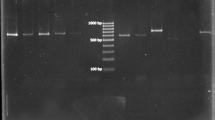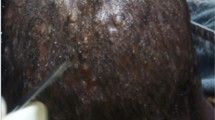Abstract
The study was a clinico-mycological approach to find out the various clinical types of dermatophytoses and as well as the species of dermatophytes in Goa. Various socio-demographic and host factors were assessed to determine the predisposing factors for dermatophytoses. A detailed clinical history of the patients was recorded. Samples were collected aseptically in sterile black paper envelopes. The material was subjected to microscopy using potassium hydroxide mount. Culture was done by inoculating the material in Sabouraud’s peptone glucose agar slants. Tinea corporis was found to be the most common clinical presentation (44.2 %). Among the dermatophytes, Trichophyton rubrum predominated (38.2 %), followed by Trichophyton mentagrophytes (27.2 %). Dermatophytoses was more common among the lower and upper lower strata of society. Majority of the patients were in the 21–40 years age group (62 %) with males predominating women in ratio 2.4:1.
Similar content being viewed by others
References
Weitzman I, Summerbell RC. The dermatophytes. Clin Microbiol Rev. 1995;8:240–59.
Rippon JW. The changing epidemiology and emerging patterns of dermatophyte species. Curr Top Med Mycol. 1985;1:209–34.
Shannon V, Heffernan MP. Fitzpatrick,s dermatology in general medicine. 7th ed. Mc Graw Hill Publishers; 2007. P. 1807–1821.
Weitzman I, Kane J. Manual of clinical microbiology. In: Balows A, Hausler Jr WJ, Herrmann KL, Isenberg HD, Shadomy HJ, editors. Dermatophytes and agents of superficial mycoses., 5Washington, D.C.: American Society for Microbiology; 1991. p. 601–6.
Kane J, Summerbell R, Sigler L, Krajden S, Land G. Laboratory handbook of dermatophytes: a clinical guide and laboratory handbook of dermatophytes and other filamentous fungi from skin, hair and nails. Star Pub Co; 1997.
Rebell G, Taplin D. Dermatophytes, their recognition and identification. Coral Gables: University of Miami Press; 1970.
Maheswari Amma SM, Paniker CKJ, Gopinathan T. Studies on dermatomycosis in Calicut (Kerala). Indian J Pathol Microbial. 1982;25:11–7.
Venkatesan G, Singh AJA, Murugesan AG, Janaki C, Shankar SG. Trichophyton rubrum—the predominant aetiological agent in human dermatophytosis in Chennai, India. Afr J Microbiol Res. 2007;1(1):9–12.
Balakumar S, Rajan S, Thirunalasundari T, Jeeva S. Epidemiology of dermatophytosis in and around Tiruchirapalli, Tamilnadu, India. Asian Pac J Trop Dis. 2012;2(4):286–9.
Pandey A, Pandey M. Isolation and characterization of dermatophytes with tines infection at Gwalior (M.P.), India. Int J Pharm Sci Investig. 2013;2(2):05–8.
Patel P, Mulla S, Patel D, Shrimali G. A study of superficial mycosis in south Gujarat region. Natl J Commun Med. 2010;1(2):85–8.
Huda MM, Chakraborty N, Bordoloi JNS. A clinico mycological study of superficial mycosis in upper Assam. Indian J Dermatol Venereal Leprol. 1995;61:329–32.
Bhatia VK, Sharma PC. Epidemiological studies on dermatophytosis in human patients in Himachal Pradesh, India. SpringerPlus. 2014;3:134.
Ranganathan S, Menon T, Sentamil GS. Effect of socioeconomic status on the prevalence of dermatophytosis in Madras. Indian J Dermatol Venereol Leprol. 1995;61:16–8.
Verenkar MP, Pinto MJ, Rodrigues S, Roque WP, Singh I. Clinico-microbiological study of dermatophytoses. Indian J Pathol Microbiol. 1991;34:186–92.
Ajello L, Georg LK. In vitro hair cultures for differentiating between atypical isolates of Trichophyton mentagrophytes and Trichophyton rubrum. Mycopathol Mycol Appl. 1957;8:3–17.
Author information
Authors and Affiliations
Corresponding author
Rights and permissions
About this article
Cite this article
Maulingkar, S.V., Pinto, M.J.W. & Rodrigues, S. A Clinico-Mycological Study of Dermatophytoses in Goa, India. Mycopathologia 178, 297–301 (2014). https://doi.org/10.1007/s11046-014-9806-9
Received:
Accepted:
Published:
Issue Date:
DOI: https://doi.org/10.1007/s11046-014-9806-9




